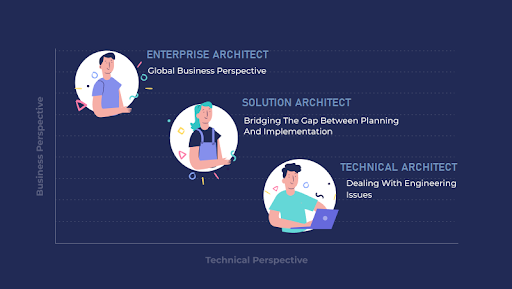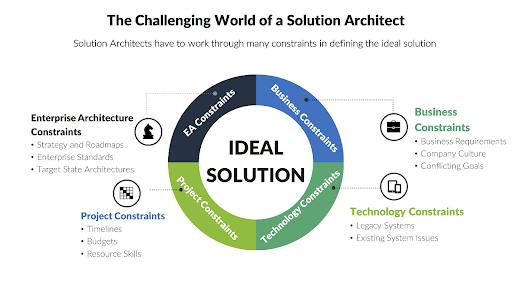Solution Architect Roles and Responsibilities
Many companies can see in advance that a project will fail. Accordingly, they have a chance to change the result and achieve success. This requires a sudden transformation of most processes to new market requirements.
Such a transformation requires specific expertise and a set of practices to align business focus with technology solutions. Otherwise, changing working methods will not improve efficiency.
Therefore, in any company that is aimed at development, the architecture of solutions is developed. This is the practice of designing, describing, and managing solutions depending on the tasks and problems of the business.
This practice has given rise to a corresponding position - the architect of solutions. This person is responsible for leading the practice and presenting the overall technical vision for a particular solution. The work of a solution architect includes many aspects and responsibilities, which will be discussed in the article. Let's take a closer look at the roles and responsibilities of this specialist on the project.
What is Solution Architect?
Software product architecture is a complex phenomenon. When someone hears about it for the first time, they often think about the application architecture of a particular project. But this is only a small part. Conventionally, it is divided into three components:
- business architecture (in the environment of developers, it is known as Enterprise Architecture);
- solution architecture (Solution Architecture);
- technological architecture.
The main focus in the first is building an ecosystem and solving top-level strategic problems (combining key requirements, analyzing data flows, etc.). Business architecture leads to understanding what technical means are needed to support a software product.
Solution architecture is an intermediate component between business processes and technological solutions. It includes the search for technical solutions for various tasks, a description of the structure and behavior of the software, and the definition of functions and stages for each solution.
The technological architecture includes engineering problems. In other words, it is the hardware component of the software product. It describes system software, firmware standards, control systems, etc.
Based on this, we see that in IT architecture, there are three corresponding job levels - Enterprise Architect (EA), Solution Architect (SA) and Technical Architect (TA).
Solutions Architect Roles & Responsibilities
We can briefly describe the difference in the work of the three architects:
- EA - what to do;
- SA - how to do;
- TA - how to maintain.
Behind the simple “how to do” in the work of a solution architect lies many tasks, such as choosing frameworks for work, monitoring the development of a software product, and resolving disputes among developers. Why is this work so important?

The speed of software product development depends on the actions of the solution architect, and this is the most important thing. Why? The faster the task is completed, the less money will be spent. From this follows the second point for which the solution architect is responsible - solving the problem within the budget. In addition, the solution architect is responsible for ensuring that all requirements are met during development. He must also study the limitations of the project to analyze feasible alternatives and reduce risks.
The solution architect links the technical team and the project manager. It ensures the speed and accuracy of information transfer and controls key development processes.
In general, a solution architect is a person who is responsible not only for the development but also for the practical implementation of ideas. He must have a clear understanding of the product and understand what value this product will bring to the business. In addition, the solution architect communicates this vision to the entire code development team so that they can create a software product.
As already mentioned, this position is a link. Accordingly, the solution architect acts at all levels of software product development:
- Idea. At the very first stage of the project, the SA collects the requirements for the software solution from the stakeholders. In particular, he gets to know the idea personally and also passes it on to business owners, top managers, as well as clients. So he identifies key problems and builds a vision for the future system.
- Implementation. This stage covers the entire software development process, including writing specifications and conducting testing. First, SA works with the technical team to think through all possible options for bringing the idea to life. He then works with the business analyst to help translate stakeholder requirements into software product functionality. Finally, SA is involved in making complex technical decisions that can affect the effectiveness of a project.
- Support. The solution architect is also responsible for the ongoing maintenance of the finished system. So, it is a guarantee that there is a safe and stable environment for the correct software operation. The solution architect also ensures that the product is up to date regarding business value.
One of the most important tasks of a solution architect is meeting stakeholder requirements. Typically, a product has a range of such contributors, including both technical and non-technical people. The goal of SA is to ensure that all its requirements are considered and implemented. Stakeholders should be regularly informed about product development processes, costs, and budgeting. It is these tasks that are assigned to the solution architect.
An integral part of development is the choice of the technology stack. The solution architect is required to participate in this procedure. The main goal, in this case, is to find which stack will be most suitable for a particular project.
Among other things, the responsibilities of a solution architect include:
- conducting a system assessment;
- analysis of the technological environment;
- defining the scope of cooperation;
- defining a procedure and process to ensure solution delivery;
- creating a solution prototype;
- adherence to strategic guidelines;
- development control;
- collaboration with project management teams.
Solution Architect Skills and Background
A solution architect is neither the highest nor the lowest link in the process of developing a software product. Still, without one, it is impossible to get the desired result. That is why the solution architect must have both general project management skills and exceptional abilities.
Expert communication
The role of the SA is to ensure that the project is completed on time. Therefore, he must be able to clearly communicate each solution's technical aspects, risks, problems, and benefits.
SA is central to all parties involved in a solution, from business analysts to developers. Accordingly, he should be able to explain the chosen approaches at all levels. At the same time, he needs to have human qualities to provide advice and explanations, negotiate and exert a positive influence.
Management of risks
How to reduce risks? You must be able to use performance, security, user interaction, and other tests. If SA cannot analyze the performance of such tests, then its work will be unsuccessful.
Technical knowledge
SA will not be able to advise or explain a solution unless it has sufficient knowledge of the technical aspects of the project. Such a position implies an understanding of all the technical disciplines that are involved in the development.
Detail orientation
Thoroughness is essential during the development of a software product. But this character trait is developed differently for everyone. A solution architect is a person who has to pay the most attention to detail. After all, it is they who determine the possible risks and also helps to separate the valuable and insignificant elements of the software product.
Rational distribution
A large amount of resources is needed to ensure fast and high-quality results. But if they are distributed incorrectly, the result will still be negative. The solution architect must be aware of all the resources available to him and use them optimally.
Analytical skills
Solution development requires understanding how the various parts of the business are connected. Therefore, SA must understand the corporate strategy and implement all business processes that determine how to achieve the company's goals. Thus, the solution architect must constantly conduct analytical work at different levels of the business.
Solution Architect Certification
Certifications help professionals demonstrate their expertise and experience in a particular technology. Here is a list of the most popular certification programs among solution architects:
AWS Solution Architect Certification
These credentials help organizations identify and develop employee talents with skills critical to cloud innovation. Earning the AWS Certified Solutions Architect - Associate certification validates your ability to design and implement distributed systems on AWS.
Azure Solution Architect Certification
Azure Solutions Architect is a Cloud Architect that builds solutions for Microsoft Azure Cloud. A typical Azure Architect is a senior technical person with at least 10 years of experience building and managing software solutions.
ITIL Solution Architect Certification
ITIL is a popular IT management framework enterprise architects use to help manage service processes. If you work in an ITSM environment with the ITIL framework, the Axelos ITIL Master certification is useful for demonstrating your aptitude in service management.
Google Cloud Solution Architect Certification
The Professional Cloud Architect certification exam assesses your ability to: Design and plan a cloud solution architecture. Manage and provision the cloud solution infrastructure. Design for security and compliance. Analyze and optimize technical and business processes.
When Do You Need a Solution Architect
Sometimes it seems that the project manager can solve most of these issues. Some of them are approved by the business owner. But why do companies hire solution architects and how much do they pay for such work?

The answer is that SA takes a huge burden off the shoulders of project managers, and even more so business owners. He spends his time sorting out the details and ensuring full interaction. Selecting a solution architect provides the following benefits:
- Correct selection. If SA is involved in the development, you can be completely sure that the new software product will solve key business problems. This means that at the end of development, the company gets not just a working application but a product that will lead to scaling.
- Effective communication. The business owner and the programmer are people “from different planets”. While the former talk about cutting costs, the latter worry about specific engineering challenges. The solution architect acts as a translator. He has both industry and technical experience, so he understands what the business owner wants and how to properly present it to the developer (and vice versa).
- Resource management. There are no projects without limits. Budget, deadlines, technology - everything needs to be managed. To do this, you need to allocate a lot of time and have relevant experience. A solution architect can see the big picture but always pays attention to the details. This is how he selects the best options for solving problems to allocate resources optimally.
- Risk reduction. The responsibilities of a solution architect are focused on the gradual and reliable completion of the project. It is he who is responsible for all unplanned situations and their consequences. But he is always ready for them. By observing the development of a software product, he can identify problems that were missed by other project participants and find a solution for them.
The solution architect is, in a way, the project's core. Without it, many problems would have gone unnoticed. In addition, teams would spend significantly more time developing the software product.
Thus, companies pay for the optimization of business processes and the creation of conditions for scaling. How much? On average - 100 thousand dollars a year. At the same time, the solution architect does not receive less than 80 thousand. But the maximum figure already depends on the country and the company in which the person works. For example, in Australia, in 2019, the maximum SA salary was $106,000, while in the US, it was $196,000.
How Ardas Can Help You
Solution architecture is at the heart of any IT project, whether or not it is practiced. By deliberately implementing a solution architecture, a company creates a structure that integrates the technology, resources, and skills of a team with specific business goals.
Before starting work on a new project, it is necessary to study the structure of the company and the basic requirements. Of course, you can do it in person. However, you can delegate all relevant authority to the solution architect. Its role and significance will be noticed instantly. Cooperating with Ardas, you do not need to tire yourself with the search for a qualified IT solution architect. We will ensure that such an expert becomes part of the team working on your project and match all points of the solutions architect description.
